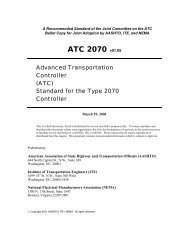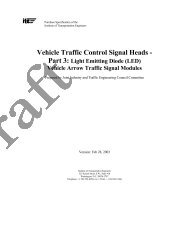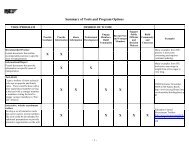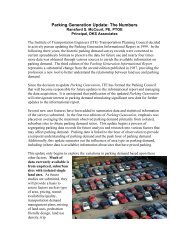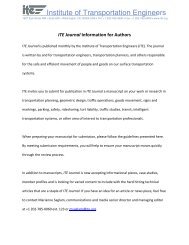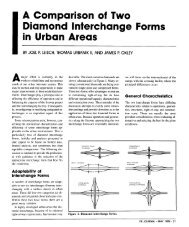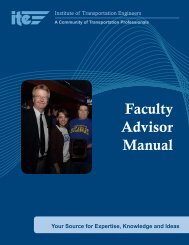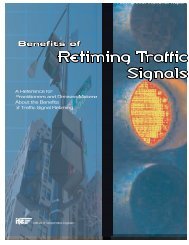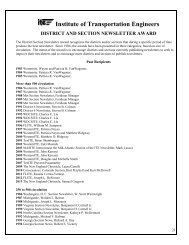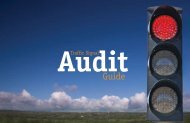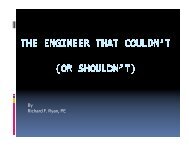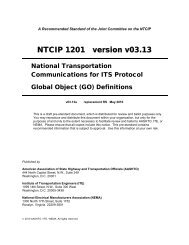Timing of Intergreen Periods at Signalized Intersections - Institute of ...
Timing of Intergreen Periods at Signalized Intersections - Institute of ...
Timing of Intergreen Periods at Signalized Intersections - Institute of ...
You also want an ePaper? Increase the reach of your titles
YUMPU automatically turns print PDFs into web optimized ePapers that Google loves.
<strong>Timing</strong> <strong>of</strong> <strong>Intergreen</strong> <strong>Periods</strong> <strong>at</strong><br />
<strong>Signalized</strong> <strong>Intersections</strong>:<br />
The German Method<br />
by Hans-Georg Retzko and Manfred Boltze<br />
Recently several reports on timing<br />
<strong>of</strong> intergreen periods <strong>at</strong> signalized<br />
intersections have appeared<br />
in American magazines. We assume<br />
this problem is intensively being discussed<br />
in the United St<strong>at</strong>es. The article<br />
“Effect <strong>of</strong> Clearance Interval <strong>Timing</strong> on<br />
Traffic Flow and Crashes <strong>at</strong> <strong>Signalized</strong><br />
<strong>Intersections</strong>” by Zador, et al., reports a<br />
strong correl<strong>at</strong>ion between the “clearance<br />
interval dur<strong>at</strong>ion” and the accident<br />
density <strong>at</strong> a signalized intersection. The<br />
final remark th<strong>at</strong> a suitable procedure for<br />
calcul<strong>at</strong>ing clearance interval timing<br />
should be applied for guaranteeing sufficient<br />
safety seems to be the correct<br />
approach because <strong>of</strong> being goal oriented.<br />
The “trial-and-error” method for<br />
finding the best solution must be rejected,<br />
because the “errors” are accidents.<br />
An article by Susan Jourdain in Faffic<br />
Engineering and Control gave recommend<strong>at</strong>ions<br />
for amber and all-red timings<br />
from British and American points <strong>of</strong><br />
view. Howard Stein then published a review<br />
in lianspoti<strong>at</strong>ion Quarterly on today’s<br />
policies and practices <strong>of</strong> intergreen<br />
timing in the United St<strong>at</strong>es.<br />
We intend to contribute to these discussions<br />
by introducing an algorithm<br />
th<strong>at</strong> is part <strong>of</strong> the <strong>of</strong>ficial signal timing<br />
standards (RiLSA) in the Federal Republic<br />
<strong>of</strong> Germany and th<strong>at</strong> is in widespread<br />
use there. In addition, we will report<br />
about a new approach <strong>of</strong> timing<br />
intergreen periods. (The not rounded<br />
numbers in this article result from the<br />
transform<strong>at</strong>ion <strong>of</strong> metric units into American<br />
ones.)<br />
<strong>Timing</strong> <strong>of</strong> <strong>Intergreen</strong> <strong>Periods</strong><br />
According to German Standards<br />
The definition reflects the philosophy<br />
<strong>of</strong> the procedure: the intergreen time is<br />
the time between the end <strong>of</strong> the green<br />
time <strong>of</strong> a traffic flow and the beginning<br />
<strong>of</strong> the green time <strong>of</strong> another (conflicting)<br />
flow, which will cross or merge the first<br />
one. During the intergreen time different<br />
oper<strong>at</strong>ions occur—overrunning, clearing,<br />
and entering.<br />
Overrun time, to,is understood to be<br />
the time between the end <strong>of</strong> the green<br />
time and the point <strong>of</strong> time <strong>at</strong> which the<br />
last vehicle <strong>of</strong> the ending green time<br />
passes the stop line. Clearance time, tc,<br />
is the time necessary for the last vehicle<br />
<strong>of</strong> the ending green time to drive the<br />
clearance distance (distance from the<br />
stop line until having cleared the conflict<br />
area). Entrance time, te,is the time necessary<br />
for the first vehicle <strong>of</strong> the beginning<br />
green time to pass the entrance distance,<br />
th<strong>at</strong> is the distance from the stop<br />
line until arriving <strong>at</strong> the conflict area. The<br />
last vehicle <strong>of</strong> the ending green time<br />
must have cleared the conflict area when<br />
the first vehicle <strong>of</strong> the beginning green<br />
time arrives <strong>at</strong> the conflict area (Figure<br />
1). <strong>Intergreen</strong> time (t,) is equal to overrun<br />
time plus clearance time minus entrance<br />
time:<br />
t,=to+tc–te (1)<br />
To determine intergreen times in a way<br />
th<strong>at</strong> conflicts will not occur is impossible.<br />
Assumptions are necessa~ for describing<br />
the oper<strong>at</strong>ions during signal stage<br />
change. Some p<strong>at</strong>terns <strong>of</strong> “normal” be-<br />
havior can be presumed. According to<br />
empirical d<strong>at</strong>a the parameters can be<br />
chosen to such an extent th<strong>at</strong> even the<br />
most critical combin<strong>at</strong>ion <strong>of</strong> these parameters<br />
is considered within certain<br />
limits.<br />
Overrun Time<br />
We assume th<strong>at</strong> a driver will stop <strong>at</strong><br />
the beginning <strong>of</strong> the amber interval if he<br />
can do this without danger. (This assumption<br />
is in accordance to the legal<br />
traffic regul<strong>at</strong>ions in the Federal Republic<br />
<strong>of</strong> Germany.) Stopping is possible<br />
when there is a definite distance d. up<br />
to the stopping line <strong>at</strong> the moment <strong>of</strong> the<br />
Figure 1. Clearance distance and entrance<br />
distance for the timing <strong>of</strong> intergrean<br />
periods. dm = clearance distance<br />
for the last vehicle <strong>of</strong> stream A. d.. =<br />
entrance distance for the first vehicle <strong>of</strong><br />
stream B.<br />
ITEJOURNAL/SEF’TEMBER1987 23
decision to stop. This moment is the end<br />
<strong>of</strong> green time, and, the beginning <strong>of</strong> the<br />
amber interval. Th<strong>at</strong> means<br />
d,=v. tre+; (2)<br />
Where<br />
d, = distance up to the stopping line,<br />
v= approach speed <strong>at</strong> the moment<br />
<strong>of</strong> the end <strong>of</strong> green time/the beginning<br />
<strong>of</strong> amber interval,<br />
t,. = reaction time, and<br />
b = deceler<strong>at</strong>ion r<strong>at</strong>e.<br />
The approach speed can be assumed<br />
to equal the speed limit. Reaction time<br />
can be assumed as 1 see, and the deceler<strong>at</strong>ion<br />
r<strong>at</strong>e may be 11.5 ft/sec2.<br />
Assuming th<strong>at</strong> the speed <strong>of</strong> the last<br />
vehicle <strong>of</strong> the ending green time does not<br />
change in the intersection area, the overrun<br />
time is<br />
t = d(t’)<br />
o<br />
v<br />
(3)<br />
Where<br />
d(t’) = distance up to the stop line <strong>at</strong><br />
the moment <strong>of</strong> the end <strong>of</strong><br />
green time and<br />
v = speed.<br />
Driving is allowed if<br />
d(t’) ~ d. (4)<br />
Therefore the maximum overrun time<br />
is<br />
maxtO=~=fre+fi (5)<br />
This means th<strong>at</strong> the maximum overrun<br />
time th<strong>at</strong> considers behavior according<br />
to the traff ic situ<strong>at</strong>ion depends on the<br />
reaction time tre, the approach speed v,<br />
and the deceler<strong>at</strong>ion r<strong>at</strong>e b.<br />
To avoid overrunning a red signal the<br />
dur<strong>at</strong>ion <strong>of</strong> the amber interval should be<br />
equal to the maximum overrun time.<br />
Clearance Time<br />
The clearance time is<br />
The System Th<strong>at</strong> Works<br />
OSAM MASTER<br />
1- TELEPHONE<br />
SYSTEM<br />
● OSAM Master controls<br />
4 Independent System groups,<br />
. 32 <strong>Intersections</strong> per<br />
OSAM Master.<br />
● Controls both 820A and<br />
170 controllers in same<br />
system group.<br />
● Master has Internal Real-Time<br />
Intersection display — no<br />
computer necessary.<br />
● 16 OSAM Masters corltrol led<br />
by optional PC-AT-Comp<strong>at</strong>ible<br />
Computer.<br />
24 ITEJOURFUWSEPTEMBER 1887<br />
820A CONTROLLER<br />
~ DEDICATED<br />
CABLE NETWORK<br />
● Autom<strong>at</strong>ically calcul<strong>at</strong>es<br />
permissive periods and<br />
force-<strong>of</strong>fs.<br />
● 8 Detector plans — each with<br />
16 programmable inputs for<br />
delay, stretch.<br />
● Internal detettor switching<br />
programmable by phase<br />
green or queue detection.<br />
● 8 Extendible overlaps.<br />
.48 Coordin<strong>at</strong>ion plans,<br />
16 Independent free plans.<br />
Where<br />
d. = clearance distance and<br />
v= = clearing speed.<br />
(6)<br />
Conflicts do not happen if it is assumed<br />
when determining intergreen<br />
time th<strong>at</strong> clearing ends <strong>at</strong> the earliest<br />
when the last clearing vehicle has<br />
passed the conflict area (see Figure 1).<br />
So the clearing distance dC is the distance<br />
between the stop line and the end<br />
<strong>of</strong> the conflict area plus the length f. <strong>of</strong><br />
the clearing vehicle (see Figure 1—dC.).<br />
The length <strong>of</strong> the clearing vehicle maybe<br />
L = 20 ft on the average.<br />
The clearing speed v= is th<strong>at</strong> speed<br />
with which the last clearing vehicle<br />
drives over the clearance distance d..<br />
The maximum value is equal to the<br />
speed limit <strong>at</strong> the intersection. The minimum<br />
value considers vehicles with low<br />
speed (v= = 23 RLsec). Only for vehicles<br />
th<strong>at</strong> have to pass small curves, v= may<br />
be assumed to be lower, for example<br />
16.4 ft/sec for R
Where<br />
t. = entry time,<br />
de = entering distance,<br />
d. = start position <strong>at</strong> the stop line (4.9<br />
ft),<br />
b = acceler<strong>at</strong>ion r<strong>at</strong>e (11.5 fVsec2),<br />
and<br />
t RY = red and yellow interval (1 see).<br />
For the “flying” start we consider the<br />
entering speed to be 24.9 mph (36.5 W<br />
see). (Please consider the inf Iuence <strong>of</strong><br />
the red and yellow signal if using these<br />
values in the United St<strong>at</strong>es.)<br />
so<br />
t.=:<br />
e<br />
(8)<br />
There are specific assumptions being<br />
made for pedestrians and cyclists. They<br />
shall not be mentioned here.<br />
<strong>Intergreen</strong> Time Diagram<br />
The intergreen time diagram used in<br />
the Federal Republic <strong>of</strong> Germany considers<br />
the red and yellow interval <strong>of</strong> 1<br />
sec. It is shown in Figure 2.<br />
Procedure<br />
First we have to determine which traffic<br />
flows have conflicts with each other<br />
when the stages change. For all possible<br />
cases the intergreen times must be calcul<strong>at</strong>ed.<br />
They are brought up to round<br />
figures. The results can be shown by a<br />
m<strong>at</strong>rix (see Figure 3).<br />
If several streams have a common<br />
signaliz<strong>at</strong>ion, the longest intergreen time<br />
is chosen. The final signal program must<br />
contain all intergreen times.<br />
A New Approach to <strong>Timing</strong><br />
<strong>Intergreen</strong> <strong>Periods</strong><br />
The preceding procedure <strong>of</strong> calcul<strong>at</strong>ing<br />
intergreen times may be criticized. It<br />
may be said th<strong>at</strong> traffic flow during the<br />
changes <strong>of</strong> the stages is a stochastic<br />
process. Or it may be asked why such a<br />
sophistic<strong>at</strong>ed procedure must be done if<br />
in this procedure many assumptions<br />
have to be made. Therefore, Jakob developed<br />
<strong>at</strong> our institute a new approach<br />
th<strong>at</strong> depends on a probabilistic tre<strong>at</strong>ment.<br />
All cases <strong>of</strong> conflicts are classified<br />
to typical cases. For every type <strong>of</strong> conflict<br />
a specific intergreen time is determined<br />
wherein the traffic streams th<strong>at</strong><br />
form a conflict can be altern<strong>at</strong>ively<br />
tre<strong>at</strong>ed as “clearing” or ‘entering” (see<br />
Figure 4). The intergreen time values<br />
4X4-L<br />
‘) L_.-\\l<br />
I I<br />
.<br />
+<br />
d[ [ftl<br />
150 200 de [ft]<br />
I II<br />
I---i-7-’”’ “@h<br />
‘tmrrt;’rn I I I<br />
Figure 2. Diagram for the timing <strong>of</strong> intergreen periods.<br />
Figure 3. Example <strong>of</strong> an intergreen time m<strong>at</strong>rix.<br />
[s1<br />
.11<br />
9<br />
JH<br />
?It<br />
12<br />
8<br />
----- IL<br />
5<br />
‘!<br />
+’<br />
7 ei<br />
HE JOURNAUSEPTEMBER 19a7 25<br />
t<br />
15
have to be increased if there are triangular<br />
islands and/or divisional islands.<br />
Only car traffic is considered, in so far<br />
as the new approach has disadvantages.<br />
The new approach <strong>of</strong> intergreen<br />
timing can be applied to intersections<br />
with “normal” character. If cyclists are<br />
signalized together with car traffic <strong>at</strong><br />
large intersections one must add a value<br />
according Figure 5.<br />
It could be proved th<strong>at</strong> the new approach<br />
<strong>of</strong> intergreen time determin<strong>at</strong>ion<br />
works much quicker than the “classic”<br />
procedure and also guarantees safe<br />
tersections. The new approach is not yet<br />
allowed to be used in Germany because<br />
<strong>of</strong> juridical consider<strong>at</strong>ions.<br />
Final Remark<br />
Calcul<strong>at</strong>ions <strong>of</strong> intergreen times for<br />
signal programs are <strong>of</strong> the gre<strong>at</strong>est importance.<br />
Correct intergreen timing<br />
guarantees safe traffic oper<strong>at</strong>ions during<br />
changes <strong>of</strong> stages. <strong>Intergreen</strong> timing<br />
cannot be determined by trial-and-error<br />
methods. The German method is described<br />
in this article. We ask U.S. traffic<br />
traffic oper<strong>at</strong>ion <strong>at</strong> signalized street in- engineers to test our procedure.<br />
aacaa clearing — clearlng<br />
entering<br />
Clnocl entering<br />
case <strong>of</strong><br />
,fandard +r,angu,a:“C;:n:;;,,,and conflict Stmdmd,::r::l:::d<br />
form island (wldthl form (width)<br />
20 Lo[ftl , ko [ftl 20 Lo[ftl >40[ft<br />
7 +2 +1 +2 /“<br />
,,~,,:<br />
Oaaaaan ‘“”<br />
7 +2 +1 +2<br />
“’;’;“:<br />
,,. ,:: :.<br />
..,<br />
4 - -<br />
:.:<br />
,.{, ,:;,,,<br />
... :,:.::<br />
J, 00000<br />
........ ...:,,,.,~ ;:,.;:<br />
4 - -<br />
6 - +1 +2 +.= :0.. 5 - -<br />
1<br />
6 - +1 +2 OGOO ,<br />
1; ....<br />
6 - -<br />
5 -- +1 +2 %“ ‘o. 5 - -<br />
...,,.. :’”<br />
........ f?<br />
0<br />
5 - - - =<br />
1<br />
000””’ 5<br />
:,‘~<br />
+1 +2<br />
4 - +1 +2 aucu ““ 6 - -<br />
~ &;..,<br />
Figure 4. <strong>Timing</strong> <strong>of</strong> intergreen periods according to Jakob.<br />
26 ITEJOURNAL/SEF’IEMBER1987<br />
1<br />
Bibliography<br />
Richtlinien fur Lichtsignalanlagen, Ausgabe 1981.<br />
Hrsg.: Forschu s esellschaft fur Stra13en- und<br />
Verkehrsweserr’&%V), Koln.<br />
Aktuelle Themen der Lichtsignalsteuerung, Ausabe<br />
1985. Hrsg,: Forschun s esellschaft fur<br />
&ra13en- uncl Verkehrswesen ~ F&W),<br />
Koln,<br />
Frantzeskakis, John M. “Signal Change Intervals<br />
and Intersection Geometry” fian.sport<strong>at</strong>ion C)uartedy,<br />
Vol. 38, No. 1, January 1984, pp. 47-58.<br />
Jakob, G. Wahrscheinlichkeitstheoretische Untersuchungen<br />
zur Bemessung von Zwischenzeiten<br />
in Signalprogrammen. Technische Hochschule<br />
Darmstadt, 1980.<br />
Jourdain, S. “lntergreen <strong>Timing</strong>s. ” i?affic /3rgineerirrg<br />
and Contro/, April 1986, pp. 179-182.<br />
Stein, Howard S. “Traffic Signal Change Intervals:<br />
Policies, Practices, and Safety, ” 7i’ansport<strong>at</strong>ion<br />
Quarterly, Vol. 40, No. 3, July 1986, pp. 433-445.<br />
Zador, P; Stein, H,; Shapiro, S,; et al, “Effect <strong>of</strong><br />
Clearance Interval <strong>Timing</strong> on Traffic Flow and<br />
Crashes <strong>at</strong> <strong>Signalized</strong> <strong>Intersections</strong>,” /TEJourna/,<br />
Vol. 55, No, 11, November 1985, pp. 36-39. I<br />
Hans-Georg Retzko<br />
received his doctor<br />
degree in engineering<br />
from the Technicai<br />
University Hannover<br />
(1961 ). Since 1966<br />
Retzko has been pr<strong>of</strong>essor<br />
for traffic and<br />
transport engineering<br />
<strong>at</strong> the technical University<br />
Darmstadt. He<br />
serves as consultant for federal and st<strong>at</strong>e departments,<br />
regional authorities, and other<br />
public or priv<strong>at</strong>e institutions.<br />
Manfred Boltze received<br />
his Diplom <strong>of</strong><br />
Civil En ineering in<br />
1984 <strong>at</strong> t\ e Technical<br />
University Darmstadt.<br />
He is now research<br />
assistant <strong>at</strong> the Fachgebiet<br />
Verkehrs planuna<br />
und Verkehrstechnik”<br />
(Traffic Department)<br />
<strong>at</strong> the Technical<br />
University Darmstadt and specializes in traffic<br />
controi technique research.<br />
increase for cyclists<br />
,OecI earln~<br />
-entering<br />
case <strong>of</strong> - clearln~<br />
CJO=Qnterln[<br />
conflict<br />
1<br />
+1 +0. . . . . .<br />
+1 10-0- +1<br />
Figure 5. <strong>Timing</strong> <strong>of</strong> intergreen periods according<br />
to Jakob—increase for cyciists.



